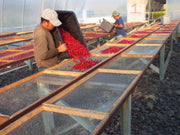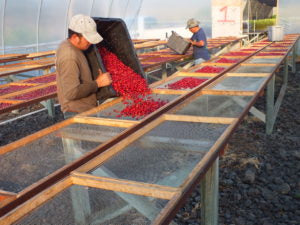HISTORY OF COFFEE IN THE USA
The Aromatic Journey: A History of Coffee in the United States
Coffee, often called “black gold,” has become an integral part of American life, culture, and economy. From colonial roots to modern café culture, the journey of coffee in the United States is a fascinating story of trade, innovation, and social change.
Colonial America
While coffee's journey began thousands of miles away in Ethiopia and the Arab world, its arrival in the United States can be traced back to the colonial period. In the 17th century, American colonists obtained coffee through trade routes established by Europeans. The Dutch and French were among the first Europeans to bring coffee beans to the New World, often importing them as luxury goods. Coffee was imported primarily from the Caribbean, South America, and European-controlled Caribbean colonies such as Saint-Domingue (now Haiti) and Jamaica. Coffee houses began to spring up in major cities such as Boston, Philadelphia, and New York, serving as centers of social, political, and intellectual exchange. Notably, the Tontine Coffee House in New York City, established in 1793, became a hub for merchants and stock traders, laying groundwork for what would become the New York Stock Exchange.
The American Revolution
Coffee's rise coincided with revolutionary sentiments. Drinking tea was associated with British colonial rule, and during the American Revolution, the Boston Tea Party of 1773 symbolized resistance. In contrast, coffee became a patriotic beverage, embraced by revolutionaries eager to forge a new national identity. Benjamin Franklin famously advocated for coffee as a patriotic alternative to tea, criticizing the British-imposed tea tax. Moreover, coffeehouses served as meeting places for revolutionaries and thinkers, such as the Sons of Liberty, where ideas about independence were brewed alongside coffee. Coffee houses played significant roles in shaping public opinion during the American Revolution, earning the nickname “penny universities” for the affordable and social nature of these establishments.
The Civil War
The Civil War (1861–1865) established coffee as an essential staple for American troops. Soldiers in both Union and Confederate armies relied on coffee as a morale booster and a source of energy. The Union, in particular, increased efforts to supply coffee to soldiers, elevating its status as a patriotic and morale-boosting beverage. Many Union soldiers carried a Sharps carbine, invented in 1859, which had a hand-cranked coffee grinder built into the buttstock — a testament to coffee’s importance on the battlefield. In the South, when Union blockades stopped coffee imports, Confederate soldiers substituted chicory for coffee. Chicory coffee remains popular today, especially in Southern states like Louisiana, where it is a cultural staple often mixed with traditional coffee.
The 19th Century: Industrialization
Prior to the 18th Century, coffee was a roasted to order drink. Green coffee beans were placed in a skillet or metal container and placed over the fireplace until done. The beans were then cracked with a mallet or pestle until they were fine enough to be brewed.
The 19th century marked a period of industrial growth and technological innovation that transformed coffee consumption. Large industrial coffee roasters were invented which allowed hundreds of pounds of coffee to be roasted at the same time. Roasted coffee in barrels began to be shipped all over the states.
New methods of coffee brewing were also created such as percolators, paper filters and later vacuum coffee makers making it easier and more convenient for Americans to enjoy coffee daily. During this time, coffee shifted from an elite luxury to an everyday staple. Instead of green coffee beans, grocers began to offer paper packages of roasted coffee beans to their customers.
The 19th century marked a period of industrial growth and technological innovation that transformed coffee consumption. Large industrial coffee roasters were invented which allowed hundreds of pounds of coffee to be roasted at the same time. Roasted coffee in barrels began to be shipped all over the states.
New methods of coffee brewing were also created such as percolators, paper filters and later vacuum coffee makers making it easier and more convenient for Americans to enjoy coffee daily. During this time, coffee shifted from an elite luxury to an everyday staple. Instead of green coffee beans, grocers began to offer paper packages of roasted coffee beans to their customers.
The expansion of railroads and urbanization facilitated widespread distribution of coffee across the country, connecting rural areas to urban centers. Additionally, the rise of large-scale coffee importers and roasters, such as Folgers (founded in 1850) and Maxwell House (introduced in 1892), helped standardize coffee consumption nationwide.
The Rise of Instant Coffee
The early 20th century saw the invention and popularity of instant coffee, with brands like Nescafé launching in the 1930s and 1940s. Instant coffee revolutionized convenience, catering to the fast-paced American lifestyle. During World War II, instant coffee served soldiers overseas, further entrenching its place in U.S. culture. Notably, Nespresso, a brand introduced by Nestlé in 1986, has become the highest-selling coffee brand globally, while Nescafé remains the second highest-selling, underscoring the global influence of these innovations.
Post-War Coffee Boom
After World War II, the American economy boomed, and coffee consumption skyrocketed. The 1950s and 1960s witnessed the rise of home brewing with the spread of automatic drip coffee makers, such as the Mr. Coffee machine introduced in 1972, which made brewing easier and more accessible.
Coffee affordability and accessibility contributed to a surge in consumption, and coffee became a symbol of American domestic life and hospitality. Mrs. Olson and “Good to the Last Drop” became part of American fokelore.
Coffee affordability and accessibility contributed to a surge in consumption, and coffee became a symbol of American domestic life and hospitality. Mrs. Olson and “Good to the Last Drop” became part of American fokelore.
Third Wave Coffee
The 1970s and 1980s marked the emergence of the specialty coffee culture. Coffeehouses like Starbucks, founded in 1971 in Seattle, began to transform the coffee landscape. Starbucks introduced the American public to espresso-based beverages and a café ambiance, shifting focus from mere caffeine consumption to a social experience. Chain coffee cafes, including Peet’s Coffee (established in 1966), Gloria Jean’s Coffees, Dunkin’ Donuts, Dutch Bros, and Scooter’s Coffee, became social hubs and workplaces.
Coffee house chains have ignited an interest in coffee quality, resulting in the creation of craft roasters who sell their coffee to small coffee shops and/or directly to home consumers. This movement also fostered a community of enthusiasts passionate about sourcing, roasting, and brewing. Coffee festivals, barista competitions, and sustainable farm practices have elevated coffee’s status from a simple morning pick-me-up to a cultural phenomenon. Additionally, the Third Wave Coffee movement emphasizes transparency in coffee sourcing, direct trade relationships with farmers, and artisanal roasting techniques, highlighting coffee as an artisanal product rather than a commodity.
The 1970s and 1980s marked the emergence of the specialty coffee culture. Coffeehouses like Starbucks, founded in 1971 in Seattle, began to transform the coffee landscape. Starbucks introduced the American public to espresso-based beverages and a café ambiance, shifting focus from mere caffeine consumption to a social experience. Chain coffee cafes, including Peet’s Coffee (established in 1966), Gloria Jean’s Coffees, Dunkin’ Donuts, Dutch Bros, and Scooter’s Coffee, became social hubs and workplaces.
Coffee house chains have ignited an interest in coffee quality, resulting in the creation of craft roasters who sell their coffee to small coffee shops and/or directly to home consumers. This movement also fostered a community of enthusiasts passionate about sourcing, roasting, and brewing. Coffee festivals, barista competitions, and sustainable farm practices have elevated coffee’s status from a simple morning pick-me-up to a cultural phenomenon. Additionally, the Third Wave Coffee movement emphasizes transparency in coffee sourcing, direct trade relationships with farmers, and artisanal roasting techniques, highlighting coffee as an artisanal product rather than a commodity.
Bon Appettit


